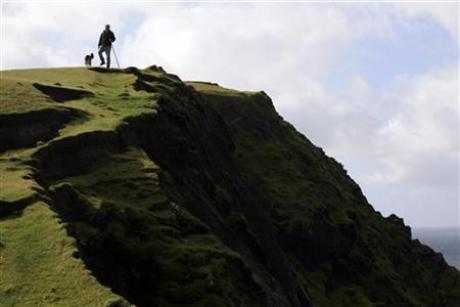Ireland's Green Dreams Need Work, Can Be Reality
Country: IRELAND
Author: Barbara Lewis

A man and his sheep dog check on sheep grazing on the common land
on Clare Island, County Mayo, Ireland September 23, 2009.
Photo: Cathal McNaughton
Ireland's ambition to shift from being 90 percent dependent on imported fossil fuel to a major user of renewables should be achievable as its urgent need for jobs helps focus politicians on overcoming planning hurdles.
Its location on the western edge of Europe, at the end of the energy supply chain, gives Ireland further incentive to go green.
The government, which includes the Green Party as a junior coalition partner, says it can meet an EU deadline for 16 percent of all its energy to come from renewables by 2020, and could even exceed it.
It has also set itself a goal to draw some 40 percent of electricity from renewables by then.
"We have doubled our renewable energy. We can double it and double it again," Eamon Ryan, Ireland's minister for communications, energy and natural resources, told the Green Party conference in Waterford, southern Ireland, at the weekend.
"It is the perfect answer to the recessionary blues."
The goals require adding roughly 6,000 megawatts (MW) of renewable energy, mostly from wind power, to the approximately 6,000 MW currently derived from conventional sources, according to industry estimates.
Siemens Ireland, a unit of German industrial conglomerate Siemens, which has been involved in renewables in Ireland since the construction of the hydroelectric power station in Shannon, western Ireland, in 1926, sees "a fair chance" of delivering on schedule.
"I am convinced we will get there. The only question mark is will we be fast enough to make the targets? I always go for speed, speed, speed," Werner Kruckow, CEO of Siemens Ireland, told Reuters.
"Unfortunately I see hurdles, especially in the public sector, which should not be there."
Those hurdles include sluggish planning processes and a weak grid, connected to Britain only via Northern Ireland, although an interconnector directly from Ireland to Britain is being built.
"Putting this much wind in Ireland is not going to be easy. It's going to need an enormous amount of change to the electricity network," said Aidan Forde, director of Saorgus Energy Limited, which specializes in developing large wind energy sites in Ireland.
"In rough terms, we're trying to double generation capacity and we already have a very weak grid. Ireland's an extreme example of what's going on in Europe. It would have a very, very high penetration of renewables. These are the aims."
In favor of their being achieved, he cited an energy minister who was "a strategic thinker" in that he appreciated fossil fuels were only cheaper in the short term.
SO FAR, SO GOOD
The green optimists say there already has been far more progress than doubters expected and so far Ireland is on course, with 15 percent of its electricity generated by renewables.
Even the country's overwhelming financial problems should not distract the government from a strong commitment to renewable energy, they say.
On the contrary, they highlight the need to redeploy the thousands of unemployed, for instance from the construction industry, in green jobs, as well as to establish a hedge against volatile oil and gas prices and to play to Ireland's established strength as a smart economy.
"It's strategic rather than ideological," said Brian Motherway, chief operations officer at the Sustainable Energy Authority of Ireland, which reports to the Department of Energy.
"It's also about developing an enterprise center. We want to export expertise," he said. "I think there's very strong government commitment to that and the smart economy. It's about leading in what Ireland is good at."
Asked about planning, he said enough projects would be approved, arguing: "What's in the queue for approval is way above what is required."
Ireland has huge natural potential to export renewable power as well as to generate it for its own needs and has around 10 times as much ocean space as land to accommodate offshore wind plants and eventually marine energy.
For now, onshore and increasingly offshore wind, with five offshore projects in the pipeline, are the most obvious providers, but advocates of marine energy say technology will eventually harness Ireland's huge wave potential.
Peter Coyle, chairman of the Marine Renewables Industry Association, said Ireland could be at the vanguard of marine energy and provide some 500 MW of power by 2020.
That 500 MW would cost around a billion euros ($1.33 billion), but as with wind, the initial investment is the major one. After that the energy cost would be predictable.
"The financing is of course of great importance, but it is not the most immediate issue. The most important issues are technology," said Coyle, who was confident utilities and banks would back investment once the technology were proven, as they have with wind.
"There is a lot of work to be done, but there is a lot of impetus behind it."
© Thomson Reuters 2010 All rights reserved
